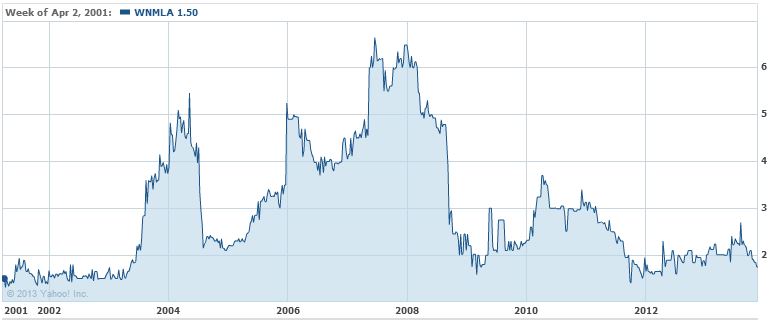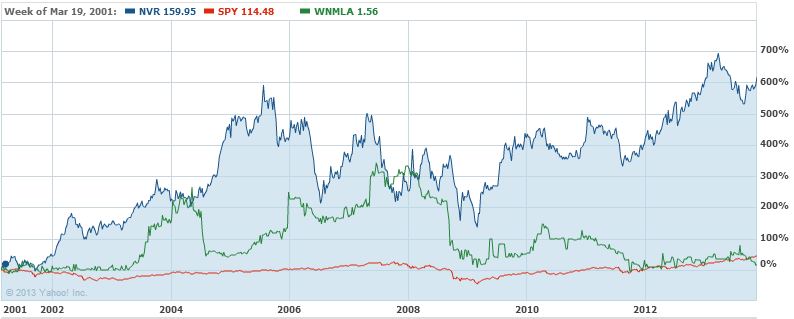Over the weekend I was reading through some Charlie479 posts on VIC (who I’ll introduce below). He recommended a company called Winmall & Co (WNMLA), a small, illiquid, management-controlled stock in 2001 that was selling for about 43% of net cash.
Below is an interesting comment Charlie479 made in response to another comment that basically stated that while the stock is in fact cheap, it wasn’t a great investment because it had been cheap for a long time and could remain cheap forever as long as management maintains control and refuses to do the things necessary to improve value (the same story that is the case with many other net-nets).
Here is the reply to that theory from Charlie479 (I combined two of his comments from that post, and the emphasis is mine):
“It is always amazing to me how many people will turn down the chance to buy $1.00 of cash for $0.40 because “you’ll never see full value”. Let me ask you this: would you ever pay $1.00 per share for a money-market fund with $1.00 per share of NAV? If that same fund offered to give you (for no compensation) shares in another money market fund worth $1.50 of NAV but that fund had a 5-year lockup, would you take those shares? I’ll bet your answer to the first question is yes (just about everyone who owns a brokerage account has bought a money market fund) and if you the answer to your first question is also yes, then the logic of panning WNMLA because “you’ll never see full value” is worth revisiting…
…Actually, I think the main reason these types of companies sell at those prices is because most folks won’t touch them until they think they have the scoop that the company is about to be sold. There is a shortage of investors that are willing to be patient and wait for the $0.45 to be liquidated into a dollar. This creates the opportunity.
I think there is just a slight disagreement between us on investing styles. I am happy to buy dollar bills for $0.45 and wait for payday to come around (as long as there is no cash burn and there are signs that management is headed in the right direction, such as selling off the brokerage and real estate operations). I don’t feel that I need to have the press release of the sale of the company in my hand to feel safe. As long as I know that I have more than $2.00 of net cash behind each $1.00 I put up, and that there are certain clues as to a potential payoff, it’s not a terrible proposition.
I do agree with your broader message: this is a cigar butt. I willingly advertise this idea as such. Cigar butts are inferior to great operating companies with defensible market positions generating 25% ROICs and selling at 8x P/E (see my NVR post). However, there are *extremely* few of these high quality companies that are trading for low values. Coke is a great company but fully priced. Ditto for Moody’s, American Express, etc. The companies that don’t have high multiples are usually average businesses that will produce average long-term rates of return on capital. Look at the VIC board. It is littered with low P/E stocks with either unexciting returns on equity or very high leverage. I’d say that the WNMLA-type cigar butts have better risk/reward than both of these two types of low P/E average businesses. I’d prefer to let cash sit in these asset-rich situations (which have potential 100% returns if any of the catalysts play out) until some of the great operating companies fall back down to 10x P/E.
That’s Great, But Who Is Charlie479?
Charlie479 is an outstanding investor turned fund manager, who runs a fund that has produced excellent returns since 2004. (Charlie is not his real name—just his username that he used for his write-ups on Joel Greenblatt’s Value Investors Club. I’ll simply refer to him as Charlie). Joel Greenblatt was a big fan of Charlie’s write-ups on VIC, and he eventually helped Charlie launch his fund, which now has over $100mn of assets under management. Charlie reportedly produced annualized returns of around 38% from 1994-2003, and since the inception of his fund through 2011 (which is the most recent data I have) he has produced about 14% returns (net of all fees) vs about 2% for the S&P 500.
In short, he’s an outstanding investor with a great long term record.
Charlie Liked WNMLA, But Loved NVR
I first heard about Charlie479 from watching Joel Greenblatt’s MBA class at Columbia. Greenblatt loved Charlie479’s simple, clear and concise write-ups on VIC, and made a few of them into case studies that he used in his MBA classes at Columbia. One of Charlie’s big investments was NVR, the homebuilder that was trading at single digit earnings multiples despite operating an excellent business model that produced outstanding returns on capital.
By the way, NVR is an interesting case study—the business model (and the high returns on capital that it produced), the management team and the capital allocation strategy, and the valuation when he wrote about it over 10 years ago ended up leading to an 8x investment return over the coming years. The company had macro-tailwinds for sure, but even absent those tailwinds, the stock was a steal in 2001.
I mention NVR to provide some color to the comment I posted above, which refers to quite the opposite type of an investment idea—namely a cigar butt Ben Graham style net net that was trading at 45% of net cash in 2001.
Charlie’s simple thesis with WNMLA was that he was buying a $1.00 for $0.45. The operating business was mediocre, but wasn’t burning through cash so Charlie basically reasoned that this was a low risk investment with 2x potential should some catalyst arise such as a sale of the company.
The investment worked out very well over the following years—eventually tripling—although it’s interesting to note that it currently trades at about the same level it did over a decade ago.
Classic picture of a net-net over the long term. This reminds me of Munger saying that if you’re a net net investor, you have to sell on the “blips” (i.e. sell as soon as you get a pop in stock price) because the business is mediocre and the long term owner of such a business will likely see his investment returns mirror the returns of the business itself.
But it’s likely that Charlie sold as the price increased, as with net-net investments you need to sell at fair value, because your margin of safety is no longer present once the stock appreciates to a certain level.
A Net-Net vs. A Cheap Compounder
This is always a debate among value investors: Is it better to look for asset based investments like Graham/Schloss and other deep value school, or is it better to strive for great businesses at reasonable prices that are almost certain to compound intrinsic value over time?
Charlie’s comments above shed light on how he thought about this… he views investments like WNMLA as a substitute for cash, but with the added upside potential catalyst that could result in the stock doubling over time. He views these as acceptable (although not his favorite) investments as long as the assets are liquid and the downside is limited. But he much prefers investments that compound intrinsic value over time. For instance, take a look at the chart of NVR, which I briefly mentioned above:
The red line is the S&P, the green line is WNMLA, and the blue line is NVR. This is just one example, but I think it does a nice job of illustrating the fate of the respective owners of those two businesses. WNMLA results have been mediocre (although they seem to have kept up with the S&P), and NVR’s results have been outstanding—shares have risen 7-fold in the last 10 years.
My Takeaway
The stock prices correspond to intrinsic value over time, and over time, NVR has compounded intrinsic value and WNMLA has not. But it doesn’t mean that at 45 cents on the dollar (literally), the latter would have been a bad investment.
Basically, Charlie479 says he likes great businesses at low prices, but those are hard to find. So in the meantime, if he can invest in a “money-market fund” with a possible 100% upside should something good happen, he’s willing to do it.
One last comment on Charlie’s comment… He points out something that I notice a lot when I peruse the write-ups on Value Investors’ Club. There are a lot of recommendations for companies that produce mediocre internal returns (ROC) that are selling at decent prices (10x earnings for example). These aren’t necessarily bad ideas in all cases, but the majority of them will lead to just average results.
The real outstanding returns come from identifying the relatively few truly undervalued situations, whether that comes from an average business selling for half of net cash, or an exceptional business selling at a single digit earnings multiple.
Have a Happy Thanksgiving!


